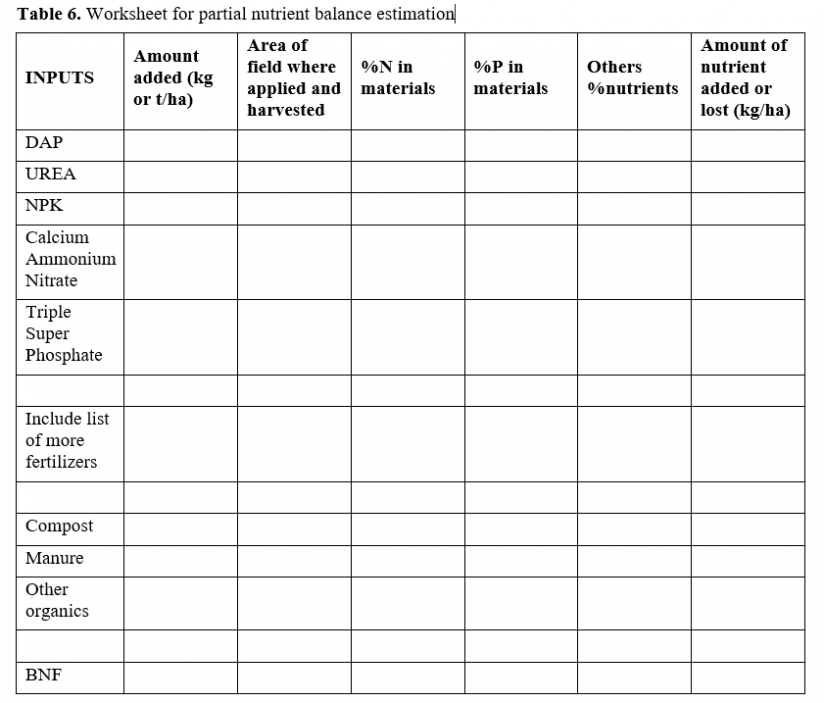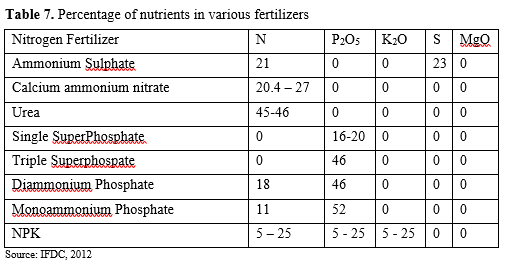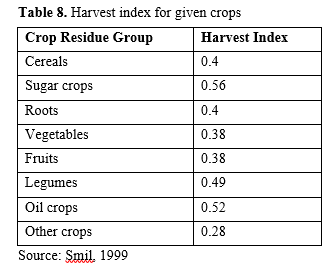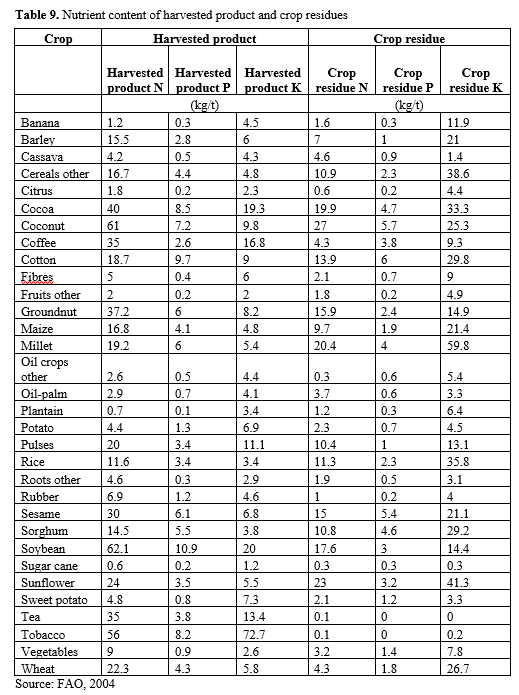You are here
Partial Nutrient Balance
A partial nutrient balance estimation is recommended as fairly simple and cost-effective means for comparing if different soil management practices are depleting (negative nutrient balance) or enriching (positive nutrient balance) the soil. By comparison, a full nutrient balance calculation would consider all nutrient additions (e.g., precipitation, mineral and organic fertilizers, biological nitrogen fixation) and losses (e.g., leaching, erosion, runoff, crop harvest, gaseous emissions). Most of these variables are quite difficult and expensive to measure, so a partial nutrient balance is used to estimate the amount of nutrients added in mineral and organic fertilizers and biological nitrogen fixation (BNF) and the amount of nutrients lost through crop (or tree or animal) harvest from a given area. If the crop residues are removed from the field, then that is loss; if the residue is kept on the field, then it is not considered a loss or an addition. Only the nutrients in the grain or fruit from the harvest are considered losses for the partial nutrient balance estimation.
How to operationalize the metric
Method of data collection and data needed to compute the method:
Here is the method for estimation of the partial nutrient balance at the field level. Information obtained from the crop grain and residue productivity metrics and from the carbon budget metrics can be used to fill in parts of the table below. Missing data on the types and amounts of fertilizers applied can be obtained from formal or informal surveys or experimental design details.
 Once this table has been completed then the amount of the nutrient applied or lost can be calculated as follows:
Once this table has been completed then the amount of the nutrient applied or lost can be calculated as follows:
The concentration of nutrients in the most commonly used fertilizers are provided in the following table.
The computation of nutrient content for fertilizers should be considered carefully. Elements like P, K, Mg that occur as oxides, it is required to use a conversion factors to convert them to the nutrients. The table below provides the conversion.
For example, if a farmer applied 100kg of diammonium phosphate (DAP), the amount of nitrogen and phosphate can be calculated as follows:
N = (100 * 0.18) =18 where the percentage of N in the fertilizer (18%) times the quantity applied of 100kg gives 18kg of nitrogen applied.
For phosphate the calculation is as follows.
P = (100 * 0.46) * 0.4364 = 20 where we multiply the amount of P2O5 in DAP (46%) by the quantity applied of 100kg, then convert it to quantity of elemental phosphate with the conversion factor (0.4364), which gives 20kg phosphate applied.
The nutrient concentrations of organic materials, including crop grains, residues, manures, and composts, can be found in a variety of sources, as summarized in the following tables.
The partial nutrient balance (kg or t/ha) is then estimated by:
If a soil is depleted (negative nutrient balance) then there may be consequence to crop growth, with some of the nutrients becoming limiting to plant growth. If the soil is fertile, then the nutrient depletion may not immediately affect plant growth, but if it continues will eventually lead to a degraded soil with reduced productive capacity. A negative nutrient balance is an indicator of unsustainable practices. If the soil is enriched (positive nutrient balance), then the level of enrichment may indicate possible levels of leaching, runoff, and/or erosion of the surplus nutrients, all of which have negative environmental impacts and indicate unsustainable practices. A neutral nutrient balance (i.e., neither positive nor negative) is the ideal and most sustainable situation.
Unit of analysis:
Partial nutrient balance estimations can be done at the field and farm level. Landscape level assessments of nutrient balance may also be done, though data are not often available and methods more difficult.
Limitations regarding estimating and interpreting:
This method is relatively easy for making comparisons among different soil and crop management practices. It provides an indication of whether the soil nutrients are being depleted or enriched. If a soil is fertile, then there may not immediately be observable consequences of depletion to soil nutrient levels and plant productivity, so this metric helps to prevent the situation of unrecognized soil nutrient depletion.






